List of rulers of Tuscany
| Grand Duke of Tuscany | |
|---|---|
 | |
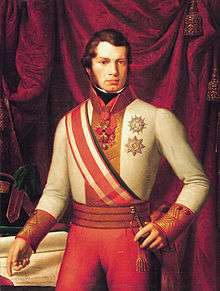 | |
| Details | |
| Style | His/her Imperial and Royal Highness |
| First monarch | Cosimo I de' Medici, Grand Duke of Tuscany |
| Last monarch |
Leopold II (de jure) Ferdinand IV (de facto/titular) |
| Formation | 27 August 1569 |
| Abolition | 16 August 1859 |
| Pretender(s) | Archduke Sigismund, Grand Duke of Tuscany |
The rulers of Tuscany have varied over time, sometimes being margraves, the rulers of handfuls of border counties and sometimes the heads of the most important family of the region.
Margraves of Tuscany, 812–1197
House of Boniface
- These were originally counts of Lucca who extended their power over the neighbouring counties.
- Boniface I, 812–823
- Boniface II, 828–834
- Aganus, 835–845
- Adalbert I, 847–886
- Adalbert II the Rich, 886–915
- Guy, 915–929
- Lambert, 929–931
House of Boso
- These were the (mostly illegitimate) relatives of Hugh of Arles, King of Italy, whom he appointed to their post after removing the dynasty of Boniface
- Boso, 931–936
- Humbert, 936–961
- Hugh the Great, 961–1001
House of Boniface (restored)
- Boniface (III), 1004–1011
Nondynastic
- Rainier, 1014–1027
House of Canossa
- These were the descendants of the Counts of Canossa.
- Boniface III, 1027–1052
- Frederick, 1052–1055
- Matilda, 1052–1115
- Beatrice of Bar, 1052–1055 (regent as mother of Frederick and Mathilda)
- Godfrey the Bearded, Duke of Lower Lorraine, 1053–1069 (regent as husband of Beatrice and step-father to Frederick and Matilda)
- Godfrey the Hunchback, Duke of Lower Lorraine, 1069–1076 (regent as husband of Matilda)
- Welf II, 1089–1095 (co-regent as husband of Matilda)
Nondynastic
- Rabodo, 1116–1119
- Conrad, 1119/20–1129/31
- Rampret, c. 1131
- Engelbert, 1134/5–1137
- Henry the Proud, 1137–1139
- Ulrich of Attems, 1139–1152 (imperial vicar)
- Welf VI, 1152–1160
- Welf VII, 1160–1167
- Rainald of Dassel, Archbishop of Cologne, 1160–1163 (imperial vicar)
- Christian of Buch, Archbishop of Mainz 1163–1173 (imperial vicar)
- Welf VI, 1167–1173
- Philip, 1195–1197
- In 1197 Philip was elected King of Germany and the majority of the Tuscan nobility, cities and bishops formed the Tuscan League with Papal backing.
- Frederick of Antioch, 1246–50 (imperial vicar)
After this, Tuscany was splintered between the competing republics of Florence, Pisa, Siena, Arezzo, Pistoia and Lucca. Since the 14th century, Florence gained dominance over Pistoia (1306, officially annexed 1530), Arezzo (1384), Pisa (1406), and Siena (1559). Lucca was an independent republic until the Napoleonic period in the 19th century.
Rulers of Florence, 1382–1569
De facto rulers of the Albizzi family, 1382–1434
- Maso degli Albizzi 1382-1417
- Rinaldo degli Albizzi 1417-1434
De facto rulers of the House of Medici, 1434–1494
| Portrait | Name | From | To | Note |
|---|---|---|---|---|
.jpg) | Cosimo de' Medici | 1434 | 1464 | First de facto Lord of Florence |
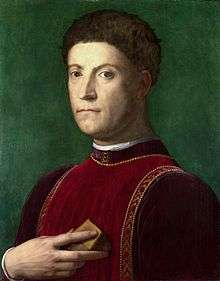 | Piero the Gouty | 1464 | 1469 | Son of Cosimo |
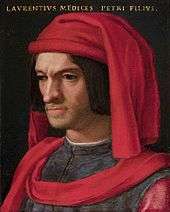 | Lorenzo the Magnificent | 1469 | 1492 | Son of Piero |
 | Giuliano de' Medici | 1469 | 1478 | Brother of Lorenzo and also Co-Ruler, was assasinated. |
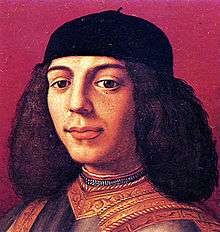 | Piero the Unfortunate | 1492 | 1494 | Son of Lorenzo, was deposed and exiled |
Republic of Florence (1494-1512)
| Portrait | Name | From | To | Note |
|---|---|---|---|---|
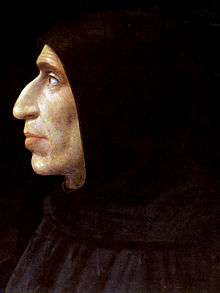 | Girolamo Savonarola | 1494 | 1498 | Inspired reform around Florence, was condemned a heretic and hanged. |
%2C_by_Ridolfo_del_Ghirlandaio.jpg) | Piero Soderini | 1502 | 1512 | was declared Standard Bearer for life, fled Florence after the Spanish Invasion. |
Rulers of the House of Medici (1512-1532)
| Portrait | Name | From | To | Note |
|---|---|---|---|---|
.jpg) | Cardinal Giovanni de' Medici | 1512 | 1513 | Son of Lorenzo, later became Pope Leo X |
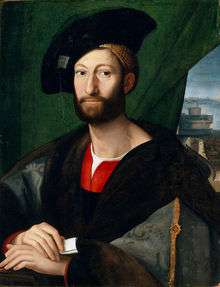 | Giuliano, Duke of Nemours | 1513 | 1516 | Son of Lorenzo |
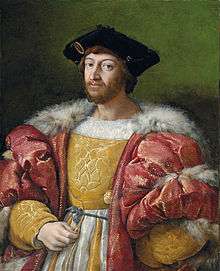 | Lorenzo II de Medici | 1516 | 1519 | Son of Piero the Unfortunate |
_-_Pope_Clement_VII_-_Google_Art_Project.jpg) | Cardinal Giulio de' Medici | 1519 | 1523 | son of Giuliano de Medici, later became Pope Clement VII |
 | Ippolito de' Medici | 1523 | 1527 | Son of Giuliano de Medici |
 | Alessandro de' Medici | 1527 | 1530 | son of Lorenzo II de Medici, ruled in exile, returned and became Duke of Florence, was Assasinated. |
After the Sack of Rome, Florence overthrew the Medicis once More and became a Republic, until Pope Clement VII, signed a peace treaty with Charles V, Holy Roman Emperor who then invaded Florence and restored the Medicis.
| Portrait | Name | From | To | Note |
|---|---|---|---|---|
 | Alessandro de' Medici | 1531 | 1532 | son of Lorenzo II de Medici, ruled in exile, returned and became Duke of Florence, was Assasinated. |
Medici Dukes of Florence, 1531–1569
| Portrait | Name | From | To | Note |
|---|---|---|---|---|
 | Alessandro de' Medici | 1532 | 1537 | son of Lorenzo II de Medici, ruled in exile, returned and became Duke of Florence, was Assasinated. |
 | Cosimo I de' Medici, Grand Duke of Tuscany | 1537 | 1569 | son of Giovanni dalle Bande Nere, later became the first Grand Duke of Tuscany. |
Medici Grand Dukes of Tuscany, 1569–1737
| Portrait | Name | From | To | Note |
|---|---|---|---|---|
 | Cosimo I de' Medici, Grand Duke of Tuscany | 1569 | 1574 | son of Giovanni dalle Bande Nere, later became the first Grand Duke of Tuscany. |
 | Francesco I de' Medici | 1574 | 1587 | son of Cosimo I de' Medici. |
| | Ferdinando I de' Medici | 1587 | 1609 | son of Cosimo |
.jpg) | Cosimo II de' Medici | 1609 | 1621 | Son of Ferdinando I |
 | Ferdinando II de' Medici | 1621 | 1670 | son of Cosimo II |
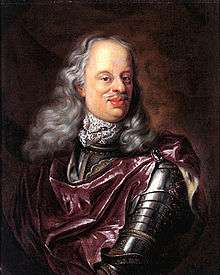 | Cosimo III de' Medici | 1670 | 1723 | son of Ferdinando II |
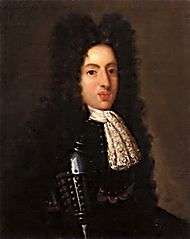 | Gian Gastone de' Medici | 1723 | 1737 | son of Cosimo III, was the last Medici Grand Duke of Tuscany. |
Habsburg-Lorraine Grand Dukes of Tuscany, 1737–1801
| Portrait | Name | From | To | Note |
|---|---|---|---|---|
 | Francesco II Stefano | 1737 | 1765 | a great-great-great-grandson of Francesco I, later became Holy Roman Emperor. |
 | Pietro Leopoldo I | 1765 | 1790 | second son of Francis I, also became Holy Roman Emperor. |
 | Ferdinando III | 1790 | 1801 | second son of Leopold I |
Bourbon-Parma Kings of Etruria, 1801–1807
| Name | Portrait | Started | Ended | Relationship with predecessor(s) |
|---|---|---|---|---|
| Lodovico I |  |
3 Aug 1801 | 27 May 1803 | Grandson of Francisco II Stefano |
| Lodovico II | 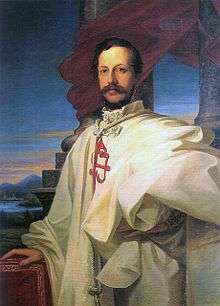 |
27 May 1803 | 10 Dec 1807 | son of Lodovico I |
Tuscany was annexed by France, 1807–1814. Napoleon's sister Elisa Bonaparte was given the honorary title of Grand Duchess of Tuscany, but did not actually rule over the region.
Habsburg-Lorraine Grand Dukes of Tuscany, 1814–1860
| Portrait | Name | From | To | Note |
|---|---|---|---|---|
 | Ferdinando III | 1814 | 1824 | Restored |
 | Leopoldo II | 1824 | 1859 | son of Ferdinando III |
 | Ferdinando IV | 1859 | 1860 | son of Leopoldo II |
Leopoldo II was driven from Tuscany by revolution from 21 February to 12 April 1849, and again on 27 April 1859. He abdicated in favor of his son, Ferdinando IV, on 21 July 1859, but Ferdinando IV was never recognized in Tuscany, and was deposed by the provisional government on 16 August. Tuscany was annexed by Piedmont-Sardinia, on 22 March 1860.
Titular Habsburg-Lorraine claimants, 1860–present
- Ferdinando IV 1860–1908
- Giuseppe Ferdinando 1908–1921
- Pietro Ferdinando 1921–1948
- Goffredo 1948–1984
- Leopoldo Francesco 1984–1993
- Sigismondo 1993–Present
See also
- List of Tuscan consorts
- Grand Duchy of Tuscany
- History of Tuscany
- Line of succession to the former Austro-Hungarian throne#Tuscany line